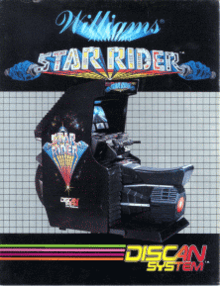Star Rider
Star Rider is a LaserDisc-based arcade racing game developed by Computer Creations and Williams Electronics and released in 1983. The object of the game is to win a futuristic motorcycle race that takes place in surrealistic settings. The tracks themselves and the background graphics are video played from a laserdisc, and are of higher quality than possible with real-time computer graphics at the time. The foreground graphics and racers are superimposed on the video. Star Rider has a rear view mirror—possibly the first racing game with one —which warns of opponents approaching from behind.[1][2]
| Star Rider | |
|---|---|
 Sales flyer showcasing the arcade cabinet. | |
| Developer(s) | Williams Electronics |
| Publisher(s) | Williams Electronics |
| Platform(s) | Arcade |
| Release | 1983 |
| Genre(s) | racing |
| Mode(s) | Single player |
Star Rider was produced in both an upright and a sit-down version where the player would sit on a replica of the cycle. It was released after the video game crash of 1983 and was not widely distributed. According to Eugene Jarvis of Williams, Star Rider was a "major dog" and resulted in or contributed to a loss of US$50 million.[3]
The title character from Sinistar and a flying mount from Joust make cameo appearances in the background graphics.
Development
The game was conceived to compete with the laserdisc game Dragon's Lair which had just come to market. R.J. Mical coordinated the project,[4] Ken Lantz directed software development, Richard Witt was lead programmer, and John Newcomer was the creative director. The laser disc video production was outsourced to a third-party company, Computer Creations, of South Bend, Indiana. Witt and Lantz developed a means by which the first few lines of NTSC video signal contained data about the roadway, so that animated riders could appear to follow the track.
Legacy
In the 1987 slasher horror movie Blood Rage, two characters, Artie (James Farrell) and Gregg (Chad Montgomery), are seen playing Star Rider on a television set. Later, Artie and Julie (Jayne Bentzen) are seen playing the game but using joysticks to control the screen.
References
- Gorzelany, Jim (April 1984). "Going Full Cycle". Video Games. 2 (7): 24–29.
- Arcade Alley Big K, 07 1984-Oct pp.72-73
- Hague, James (1997). Halcyon Days: Interviews with Classic Computer and Video Game Programmers.
- "Work History of RJ Mical".
External links
- Star Rider at the Killer List of Videogames
- Star Rider page at the Dragon's Lair Project*
- Star Rider: Arcade Laser Disc’s Last Stand at The Arcade Blogger
- Star Rider Blu-Ray (2015) by Arrow Video